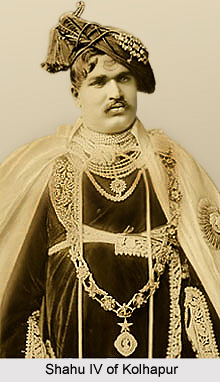 Shahu IV, also known as Chhatrapati Shahuji Maharaj and Rajarshi Shahuji Chhatrapati or Rajarshi Shahu, was the first ruler or Maharaja of the princely state of Kolhapur, during the British rule in India. He reigned over the territory from the year 1894 to 1922. The full official name and style of Shahu IV was Colonel His Highness Kshatriya Kulawatasana Sinhasanadhishwar, Shrimant Rajarshi Sir Shahu Chhatrapati Maharaj Sahib Bahadur, GCSI, GCIE, GCVO.
Shahu IV, also known as Chhatrapati Shahuji Maharaj and Rajarshi Shahuji Chhatrapati or Rajarshi Shahu, was the first ruler or Maharaja of the princely state of Kolhapur, during the British rule in India. He reigned over the territory from the year 1894 to 1922. The full official name and style of Shahu IV was Colonel His Highness Kshatriya Kulawatasana Sinhasanadhishwar, Shrimant Rajarshi Sir Shahu Chhatrapati Maharaj Sahib Bahadur, GCSI, GCIE, GCVO.
Early Life of Shahu IV
Shahu IV was born on 26th June 1874 to parents Appasaheb Ghatge, the chief of Kagal senior, and Radhabai, the daughter of the Raja of Mudhol. He was originally named as Yeshwantrao Ghatge and was the eldest son of his parents. In March 1884, Shahu IV was adopted by the widow of Raja Shivaji IV, Anandibai. His family was intimately connected with the ruling dynasty of the princely state of Kolhapur due to many generations of inter-marriage. Thus he was considered as the appropriate candidate for being the heir after being adopted, even though he was not a male member of the Bhonsle dynasty.
The British East India Company, which acted as the Government of India, appointed a council of regency to supervise affairs of Kolhapur as Shahu IV was still a minor. He was tutored and trained in administrative functions by Sir Stuart Fraser. In the year 1894, when he reached the age of majority, Shahu IV was invested with ruling powers to reign over the princely state of Kolhapur.
Rule of Shahu IV
Shahu IV was one of the most reformative and progressive rulers during that era. He took various efforts for the betterment of the lower castes, which was rather essential in the state as they were much deprived. He also undertook several steps to propagate and spread education; he subsidized education in Kolhapur and made education free which would be provided to all. Shahu IV also took measures to increase opportunities of employment for his subjects. Several hostels were built in the princely state which facilitated in providing education to the rural, low caste and indigent population.
He established numerous educational institutions through out Kolhapur, such as Deccan Rayat Aanstha, Miss Clarke Boarding School and Victoria Maratha Boarding School. Chhatrapati Shahuji Maharaj also established the Rajaram College. He also assured proper employment for the students who received education; and thus created one of the initial affirmative action programs in Indian history that considered various factors like race, gender, religion, caste etc, to benefit the deprived and counter the adverse effects of discrimination. Shahu IV also initiated Shahu Chhatrapati Weaving and Spinning Mill in the year 1906 to provide further employment opportunities. Most of the progressive measures were implemented in the year 1902.
Personal Life of Shahu IV
Shahu IV, also known as Rajarshi Shahuji Chhatrapati, was married to the daughter of a Maratha nobleman, Lakshmibai (Khanvilkar) in the year 1891. The royal couple had four children, namely, Rajaram II, Radhabai Akkasaheb Puar, Sriman Maharajkumar Shivaji and Srimati Rajkumari Aubai.
Maharaja Shahu IV of Kolhapur died on 6th May, 1922. His son Rajaram II succeeded him and ascended the throne or gadi as the new Maharaja of the princely state of Kolhapur.
Titles of Shahu IV
Through out his reign on Kolhapur, Shahu IV held various titles and styles, which are listed below-
* Meherban Shrimant Yeshwantrao Sarjerao Ghatge (1874- 1884)
* His Highness Kshatriya-Kulawatasana Sinhasanadhishwar, Shrimant Rajarshi Shahu Chhatrapati Maharaj Sahib Bahadur, Raja of Kolhapur (1884- 1895)
* His Highness Kshatriya-Kulawatasana Sinhasanadhishwar, Shrimant Rajarshi Sir Shahu Chhatrapati Maharaj Sahib Bahadur, Raja of Kolhapur, GCSI (1895- 1900)
* His Highness Kshatriya-Kulawatasana Sinhasanadhishwar, Shrimant Rajarshi Sir Shahu Chhatrapati Maharaj Sahib Bahadur, Maharaja of Kolhapur, GCSI (1900-1903)
* His Highness Kshatriya-Kulawatasana Sinhasanadhishwar, Shrimant Rajarshi Sir Shahu Chhatrapati Maharaj Sahib Bahadur, Maharaja of Kolhapur, GCSI, GCVO (1903- 1911)
* His Highness Kshatriya-Kulawatasana Sinhasanadhishwar, Shrimant Rajarshi Sir Shahu Chhatrapati Maharaj Sahib Bahadur, Maharaja of Kolhapur, GCSI, GCIE, GCVO (1911- 1915)
* Colonel His Highness Kshatriya-Kulawatasana Sinhasanadhishwar, Shrimant Rajarshi Sir Shahu Chhatrapati Maharaj Sahib Bahadur, Maharaja of Kolhapur, GCSI, GCIE, GCVO (1915- 1922)
Honours of Shahu IV
Sir Shahu IV of Kolhapur was honoured several times, which are mentioned as follows-
* Knight Grand Commander of the Order of the Star of India- GCSI (1895)
* King Edward VII Coronation Medal (1902)
* Knight Grand Cross of the Royal Victorian Order- GCVO (1903)
* Honorary LLD- Cantabrigian (1903)
* Delhi Durbar Gold Medal (1903)
* King George V Coronation Medal (1911)
* Knight Grand Commander of the Order of the Indian Empire- GCIE (1911)
* Delhi Durbar Gold Medal (1911)



















